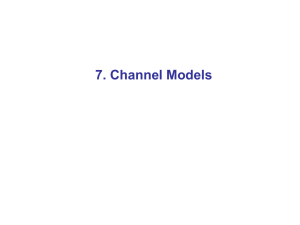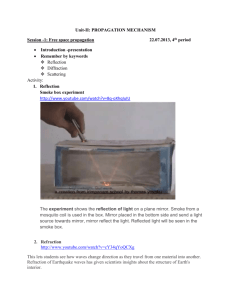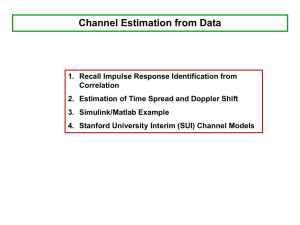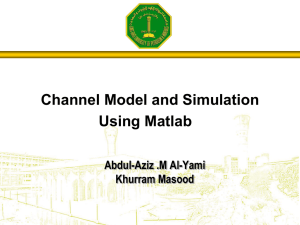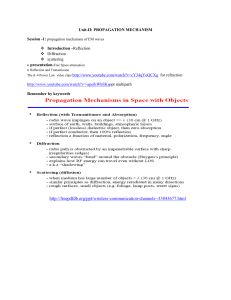Dr saad2
advertisement
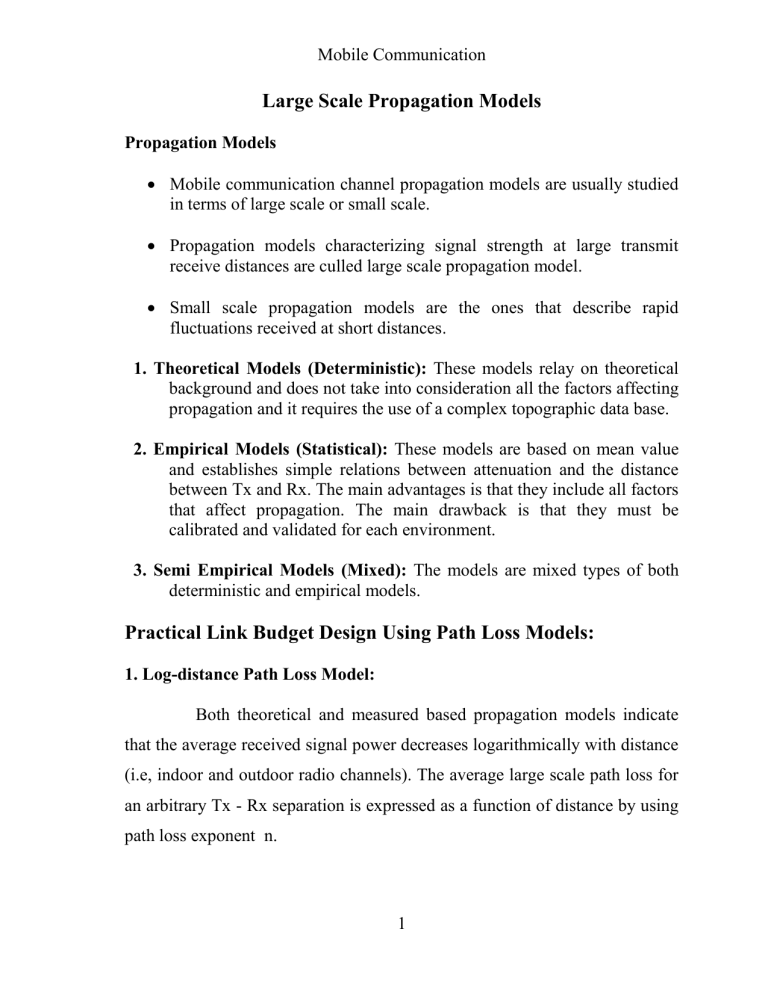
Mobile Communication Large Scale Propagation Models Propagation Models Mobile communication channel propagation models are usually studied in terms of large scale or small scale. Propagation models characterizing signal strength at large transmit receive distances are culled large scale propagation model. Small scale propagation models are the ones that describe rapid fluctuations received at short distances. 1. Theoretical Models (Deterministic): These models relay on theoretical background and does not take into consideration all the factors affecting propagation and it requires the use of a complex topographic data base. 2. Empirical Models (Statistical): These models are based on mean value and establishes simple relations between attenuation and the distance between Tx and Rx. The main advantages is that they include all factors that affect propagation. The main drawback is that they must be calibrated and validated for each environment. 3. Semi Empirical Models (Mixed): The models are mixed types of both deterministic and empirical models. Practical Link Budget Design Using Path Loss Models: 1. Log-distance Path Loss Model: Both theoretical and measured based propagation models indicate that the average received signal power decreases logarithmically with distance (i.e, indoor and outdoor radio channels). The average large scale path loss for an arbitrary Tx - Rx separation is expressed as a function of distance by using path loss exponent n. 1 Mobile Communication ̅( ) ( ( ) ) ( ) Or ̅( ) ̅( )( ) ( ) ( ) Where: n is the path loss exponent (which indicates the rate at which path loss increase with distance). do = close-in reference distance determine from measurements close to the Tx. d = Tx - Rx separation distance. do is taken as: do = l km for macrocells do = l00 m for microcclls do = 1 m for indoor The bars in equation (l) and (2) denote the ensemble average of all possible path loss values for a given value of d. The value of n depends on the specific propagation environment as shown in table (1). The reference distance should be in the far field of the antenna. The reference path loss is calculated using the free space loss equation (2a). ( ) ( )( ( ) ) [ ( ) ] 2 ( ) Mobile Communication Table 1: Path Loss Exonent For Digital Environments Environment Path Loss Exponent (n) Free space 2 2.7 – 3.5 Urban area cellular radio Shadow Urban area cellular radio 3-5 In building line of sight 1.6 – 1.8 Obstructed in building 4-6 Obstructed in factories 2-3 Outdoor Propagation Models: 1- Okumura Model: This model is most widely used for signal predication in urban area. It is applicable for[5 ch3p.p116]: ( ) Frequency range 150 MHz – 3000 MHz Range 1 km – 100 km Base station antenna height 30 m – 1000 m ( ) ( ) ( ) ( ) Where: L = median path loss (dB). LF = free space loss (dB). Amu = the median attenuation relative to free space as a function of frequency (f and distance d). G(hte) = the base station antenna height gain factor. G(hre) = the mobile station antenna height gain factor. GAREA = gain depends on the type of environment (correction factor). 3 Mobile Communication Plots of Amu(f,d) and GAREA for wide range of frequencies are shown in Fig.(1) and Fig.(2). ( ) ( ) ( ) ( ) ( ) ( ) 1000 m > > 30 m ≤ 3m 10 m > ......(4a) ......(4b) >3m .......(4c) Okumura's model is wholly based on measured data and does not provide any analytical explanation. Fig.(1): Median attenuation relative to free space (Amu(f,d)), over a quasi-smooth terrain. 4 Mobile Communication Fig.(2):Correction factor, GAREA, for different types of terrain. Example 3.10[5p.p118] Advantages of the Model: 1. Simplest and best in path loss prediction for cellular and land mobile systems in cluttered environment. 2. If is very practical and has become a standard for system planning in modern land mobile system. Disadvantages: 1. The major disadvantage is its slow response to rapid changes in terrain. 2. The model is fairly good in urban and suburban areas but not as good in rural areas. 5 Mobile Communication 2- Hata Model: Hata Model is an empirical formulation of the graphical path loss data provided by Okumura, it is valid for: Frequencies: l50 MHz - 1500 MHz. The standard formula for median path loss in Urban area is given by: LUrban(dB)=69.55 + 26.16Log(fc) – 13.82Log(hte) – a(hre) + (44.9- 6.55Log(hte))Log(d) .....(5) Where: fc = frequency 150 MHz - 1500 MHz. hte = the effective Tx (base station) antenna height in meter= 30 m to 200 m. hre = is the effective Rx (mobile) antenna height in meter = 1 m to 10 m. d = distance between BS and MS in km. a(hre) = correction factor for effective mobile antenna height which is a function of the size of the coverage area. The mobile antenna correction factor for small to medium sized city is given by: a(hre) = (1.1 Log(fc) – 0.7)hre – (1.56 Log(fc) – 0.8)dB ..... (6) For a large city: ( ) ( ) ( ( ( ( )) ... (6a) )) ( In suburban area: The path loss in equation (5) is modified as: ( ) ( ) * ( )+ 6 ...... (7) ) Mobile Communication In open rural area: For path loss in open rural areas, the formula is modified as: ( ) ( ) ( ( )) ( ) ( ) Nodes: 1. The prediction of Hata model compares very closely to Okumura model as long as d exceed 1 km. 2. This model is well suited for large cell mobile systems, but not personal communications system (PCS) which has cells of the order of 1 km radius. 3- Walfisch-Bestoni Model: The model considers the impact on roof tops and building height by using diffraction to predict average signal strength at street level. The model consider the path loss (S) to be a product of three factors[5]. S = PoQ2P1 .......(9) Po = Free space path loss between isotropic antennas given by: ( ) ( ) Q2 = The reduction in the rooftop signal due to the row of buildings which immediately shadow the receiver at street level. P1 = Term based upon diffraction and determine the signal loss from rooftop to the street in dB, the path loss is given by: S(dB) = Lo + Lrts +Lms Where: ....... (11) Lo = Free space loss. Lrts = Roottop-to-street diffraction and scatter loss. Lms = Multiscreen diffraction loss due to the rows of buildings. 7 Mobile Communication Fig.(3) illustrate the geometry used in the Walfisch-bestoni model. Fig.(3): Propagation geometry for model proposed by Walfisch-bestoni. From Fig.(3), we notice that the signals arrive at the receiver from different ways (reflection, diffraction from the 1st, 2nd and 3rd as the model show that the signals travels from rooftops)[5 ch3]. This model depends on: 1. The height of the buildings. 2. The width of the streets and the width of the buildings. 3. The distance between buildings. 4. The orientation of the streets relative to the line of sight (LOS) and nonline of sight (NLOS). 5. The distance between the Tx and receivers the height of Tx and Rx antennas and the frequency. 8 Mobile Communication Indoor Propagation: Indoor propagation is dominated by the same mechanisms as outdoor: (reflection, diffraction and scattering). The indoor radio channel differs from the traditional mobile radio in some aspects[5 p.p123]: 1. The distance covered is much smaller. 2. The variability of the environment is much greater for a much smaller range of Tx-Rx separation. 3. Propagation within buildings is strongly influenced by specific features such as: The layout of the building. The construction materials. The building type. 4. Within buildings, it is difficult to work in the far. field region for all types of antennas used. In general indoor channels may be classified either as: Line of Sight (LOS) or Obstructed (OBS). Attenuation Factor Model: An in-building site-specific propagation model that includes the effect of building type as well as the variations caused by obstacles. The attenuation factor model is given by[5p.p129]: 9 Mobile Communication ̅ ( )[ ] ̅( )[ ] [ ( ) ] ∑ [ ] ( ) Where: NSF = The exponent value for the same floor measurement. FAF = The floor attenuation factor for a specific number of buildings floor. PAF = The partition attenuation factor for a specific obstruction encountered by a ray drawn between the Tx and Rx in three dimension. In equation (12), FAF may be replaced by an exponent which already considers the effect of multi floor separation. ̅ ( )[ ] ̅( )[ ] ( ) ∑ [ ] ( ) Where: nMF = Path loss exponent based on measurements through multi floors. In buildings, it was found that path loss obeys free space plus an additional loss factor which increases exponentially with distance. Therefore equation (12) can be modified as: ̅ ( )[ ] ̅( )[ ] [ ( ) ] ∑ [ Where: α = The attenuation constant for the channel with units (dB/m). 10 ] ( ) Mobile Communication Small-Scale Fading (or short term fading model) It is used to describe rapid fluctuations of the amplitude, phase, or multiple delay of radio signal over a short period of time or travel distance. Small-Scale Multipath Fading Effects: The three most important effects are[5ch4]: 1. Rapid changes in signal strength over a small travel distance or time interval. 2. Random frequency modulation due to varying Doppler shift on different multipath signals. 3. Time dispersion (echoes) caused by multipath propagation delays. Properties of Small-Scale Multipath Propagation: Small Tx-Rx separation distances (a few wavelengths). In build-up urban areas, fading occurs due to the height of the mobile antennas are well below the height of the surrounding structures, so there is no signal line of sight path to the base station. Even when a LOS exists, multipath still occurs due to reflection from the ground and surrounding structures. The incoming radio waves arrive from different directions with different propagation delays. Multiple copies of tmnsmiued signal arriving at the receiver by different paths and at different time delays. The multipath components combine vectorially at the receiver antenna of the mobile and causes signal received by the mobile to distort or fade. Even when the mobile receiver is stationary, the received signal may fade due to the movement of the surrounding objects in the radio channel. Distribution of the signal attenuation coefficient are: Rayleigh, Rician 11 Mobile Communication Doppler Shift: Consider a mobile moving at a constant velocity v, along a path segment having length d between points X and Y, while it receives signals from a remote source S, as illustrated in Fig.(4). Fig.(4): Illustration of Doppler effect. The difference in path lengths traveled by the wave from source S to the mobile at points X and Y is , where required for the mobile to travel from X to Y, and is the time assumed to be same at points X and Y since the source is assumed to be very far away. The phase change in the received signal due to the difference in path lengths is therefore. ( ) The apparent change in frequency, or Doppler Shift, is given by fd where: ( 12 ) Mobile Communication equation (16) relate the Doppler shift to the mobile velocity and the spatial angle between the direction of motion of the mobile and the direction of arrival of the wave. It can be seen from equation (16) that if the mobile is moving toward the direction of arrival of the wave, the Doppler shift is positive (i.e., the apparent received frequency is increased), and if the mobile is moving away from the direction of arrival of the wave, the Doppler shift is negative (i.e., the apparent received frequency is decreased). Example: Consider a transmitter which radiates a sinusoidal carrier frequency of 1850 MHz. For a vehicle moving 60 mph, compute the received carrier frequency if the mobile is moving (a) directly toward the transmitter (b) directly away from the transmiuer, and (c) in a direction which is perpendicular lo the direction of arrival of the transmitted signal. Solution: Carrier frequency fc = 1850 MHz. Therefore, wavelength Vehicle speed v = 60 mph= (60*1609)/3600 = 26.82 m/s (a) The vehicle is moving directly toward the transminer. The Doppler shift in this case is positive and the received frequency is given by: (b)Thc vehicle is moving directly away from the transmitter. The Doppler shift in this case is negative and hence the received frequency is given by: (c)The vehicle is moving perpendicular to the angle of arrival of the transmitted signal. In this case, = 90°, cos = 0, and there is no Doppler shift. The received signal frequency is the same as the transmitted frequency of 1850MHz. 13 Mobile Communication Shadowing: In the case when large obstacles are represent, this causes a large fading of the radio signal this is called shadowing or blocking. This type of fade depends on the frequency of the radio signal and the penetration of the signal through the obstacles. When the signal frequency increases, the penetration strength decreases. The high frequency signals are affected to a larger extend by the obstructing objects even when objects arc small. In the presence of a building or a wall or a tree may cause the signal to be blocked and the signal is not received completely (e.g., the signals of higher frequencies transmitted by satellites). Multipath Propagation: Even when there are no obstructing objects in the direct path between the Tx and the Rx, but the obstructing objects are in the surrounding area may cause most of a difficult problem of transmission due to multipath propagation. The signal arrive at the receiver follow different path because of reflections from the obstructing objects (i.e., the line of sight signal if present will be first then followed by the reflected signals depending on the different distances each signal travels before reaching the receiver). This delay (1 st shortest distance signal to last longest distance) is called delay spread. This causes the arrival of many copies of the signal and they are of different amplitude, phase and angle of arrival causing distortion due to interference of these signals at the receiver which arrive at the receiver at different times. 14 Mobile Communication Fig.(5): Illustration of Doppler effect. Parameters of Mobile Multipath channels: 1- Time Dispersive Parameters. 2- Coherence Bandwidth and Delay Spread. 3- Doppler Spread and Coherence Time. 1- Time Dispersive Parameters: The parameters which quantify (to compare different multipath channels) the multipath channel are: The mean excess delay( ̅ ) RMS delay spread ( ). Excess delay spread (XdB). The mean excess delay is the 1st moment of the power delay profile and is defined by: ̅ ∑ ∑ ( ) ∑ ( ) ∑ ( ) The rms delay spread is the square root of the 2nd central moment of the power delay profile: √̅ (̅) ( 15 ) Mobile Communication ̅ ∑ ∑ ∑ ( ) ∑ ( ) ( ) Where P( ) is the absolute power level. These delays arc measured relative to the first detectable signal arriving at the receiver at 2- Coherence Bandwidth and Delay Spread: Delay spread ( ) is a natural phenomenon caused by reflected and scattered propagation path in a radio channel, typical values for rms delay spread ( ): In outdoor mobile radio channel ≈ microseconds In indoor mobile radio channel ≈ nanoseconds Coherence bandwidth (Bc) is a statistical measure of the range of frequencies ever which the channel can be considered flat (i.e., a channel which passes all spectral components with approximately equal gain and linear phase ). Or Coherence bandwidth (Bc) is the range of frequencies over which two frequency components have a strong potential for amplitude correlation. Two sinusoids with frequency separation greater than Bc are affected quite differently by the channel. If the coherence bandwidth is defined as the bandwidth over which the frequency correlation functíon ís above 0.9 then: ( ) If the frequency correlation function is above 0.5: 16 Mobile Communication ( ) Inter-Symbol Interference (ISI): The delay spread caused by the arrival of the signals (following different paths) at the receiver which causes pulse interference, the energy of a certain symbol is distributed over the adjacent symbols and causes what is called ISI as shown in Fig.(6). The effect of ISI increase with increase in the symbol rate. Fig.(6): ISI caused by multipath signals. 17 Mobile Communication 3- Doppler Spread and Coherence Time: Delay spread and coherence bandwidth are parameters describe the time dispersion nature of the channel in a local area, they do not offer information about the time varying nature of the channels caused by either. Relative motion between the mobile and the base station. Or movement of the objects in the channel. Doppler spread (BD): When a sinusoidal tone of frequency fc is transmitted, the received signal spectrum called Doppler spectrum will have component in the range fc - fd , fc + fd where fd is the Doppler shift. fd is a function of the relative velocity of lhe mobile and the angle Ө between the direction of motion of the mobile and direction of arrival of scatter waves. If the baseband signal bandwidlh is much greater than B D, the effects of Doppler spread are negligiblc at the receiver. This is a slow fading channels. Coherence time (TC): is the time domain dual of the Doppler spread. ( ) The definition of Coherence time (TC) implies that rwo signals arriving with a time separation greater than TC are affected differently by the channel. lf the coherence time is defined as the time over which the time correlation function is above 0.5: ( ) Where fm is the maximum Doppler shift given by 18 ⁄ Mobile Communication For modem digital communications, coherence time is defined as the geometric mean of equations 23 and 24: √ ( ) If the reciprocal ( )مقلوبbandwidth of the baseband signal is greater than the coherence time of the channel, then the channel will change during the transmission of the baseband message, casing distortion at the receiver. Types of Small-Scale Fading: 1- Fading effects due to multipath time delay spread. a- Flat fading: If the mobile channel has a constant gain an a linear phase response over a bandwidth which is greater than the bandwidth of the transmitted signal, then the received signal undergo flat fading. Where: BS : The transmined signal bandwidlh. BC : The channel bandwidth (Coherence Bandwidlh). b- Frequency selective fading: If the channel has a constant gain and a linear phase response over a bandwidth that is smaller than the bandwidth of the transmined signal then the channel creates frequency selective fading on the received signal. The received signal will be distorted and the channel induces intersymbol interference (ISI) BS > BC When Bs > Bc an equalizer needed at the receiver. 19 Mobile Communication 2- Fading effects due to Doppler spreud. a- Fast fading: the channel impulse response changes rapidly within the symbol duration. TS > TC BS < BD in frequency domain Where: TS : symbol period of the transmitted signal. TC : Coherence time. b- Slow fading: the channel impulse response changes at a rate much slower than the transmitted baseband signal. In this case the channel may be assumed to be static over one or several reciprocal bandwidth intervals. TS << TC BS >> BD in frequency domain. It should be clear that the velocity of the mobile and the baseband signal determines whether a signal undergoes fast or slow fading. 20 Mobile Communication Rayleigh and Ricean Distributions: 1- Rayleigh Fading Distribution: Rayleigh distribution for the signal arriving at the receivers when there is no tine of sight (LOS) and described as non-stationary and it occurs when the Rx is moving or the transrnitter is moving as shown in Fig.(7). Transmitter Obstacle Receiver Fig.(7): Rayleigh Fading. 2- Ricean Distribution: The probability distribution for the signal arriving at the receiver is Ricean when there is a line of signal (LOS) as shown in Fig.(8). Fig.(8): Ricean Fading. 21 Mobile Communication Comparison Between Rayleigh fading and Ricean fading: Rayleigh fading Ricean fading 1- No LOS (Multipath). 1- LOS component (direct-multipath) 2- The total energy of the signal received is 2- Adding a strong component which is the from reflections, refraction. 3- The direction of Tx is not important. LOS component to the reflect signal. 3- The direction of Tx is important due to its direct component. 4- Multipath causes destructive interference 4- The number of fades is less than in causing deep fades (20-30 d B). Rayleigh. 22

